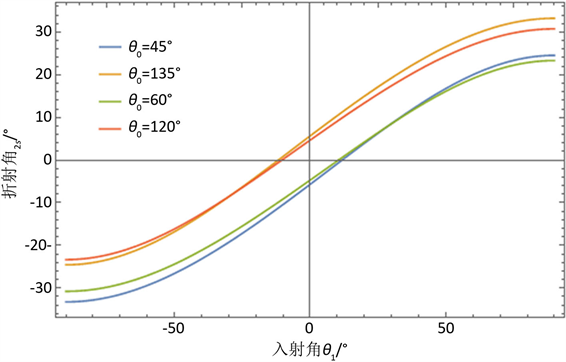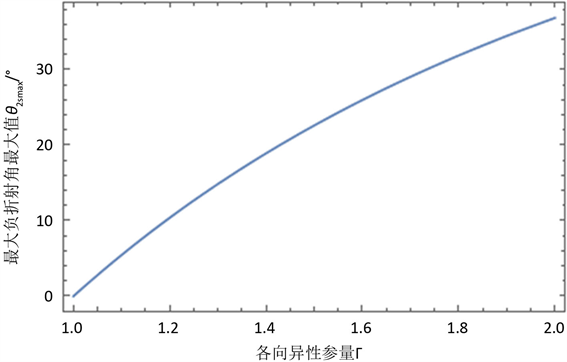1. 引言
负折射是入射光和折射光在法线同一侧的现象,与传统光折射的Snell公式不相符,可被用于制作分辨率低于波长的超透镜或完成其他特殊成像 [1] [2] [3]。Veselogo [4] 最初得出普通介质和介电常数和磁导率都为负值的人工超材料界面存在负折射,Shelby等 [5] 在研究二维铜带单元系列组成的超晶格材料时观察到负折射现象。在随后展开的大量负折射材料生成、结构设计和应用研究中发现,e光从均匀介质入射到单轴晶体表面时也可以观察到负折射现象 [6] [7] [8]。
YVO4晶体在可见光及近红外波段有良好的透光性,透光范围较宽,硬度较高,可人工生长出大块优质晶体,并且易于加工,价格较低,是光通信无源器件如光隔离器、旋光器、延迟器、偏振器中的关键材料。YVO4晶体(no = 2.02, ne = 2.25, 532 nm)相比KDP(no = 1.51, ne = 1.47, 532 nm)及其他光学晶体各向异性更强,负折射相关角度更大。为确定YVO4晶体的负折射与应用,本文详细分析YVO4晶体光轴取向不同时空气与晶体的界面上e光负折射的最大入射角与出射角范围及其与光轴角的关系,并分析e光在孪晶界面上的偏折特征。
2. YVO4晶体折射
单轴晶体的介电常数
,激光从均匀介质入射到单轴晶体界面时o光和e光传输速度不同导致双折射现象,o光遵循Snell定理,e光与光轴方向夹角不同时折射率不同不遵循Snell定理。双折射表现为o、e光相位或者出射方向的差别。从均匀介质向单轴晶体界面入射时,入射角在一定范围内,e光会出现负折射现象。负折射的临界入射角最大值和最大负折射角最大值均取决于双折射率
,且
越大临界入射角和最大负折射角越大。
自然光入射到空气和单轴晶体界面,观察到图1(a)中o光、e光两条折射光线,均为正折射,调整入射角度可以观察到图1(b)中折射e光和入射光在法线同一侧的负折射情况。YVO4晶体用于观察测量以上双折射及负折射特性,鉴于e光在单轴晶体中的特殊情况,也可用多块单轴晶体适当组合设计成相应的e光导波器件 [9] [10] [11]。
3. e光在均匀介质与YVO4晶体界面的折射
根据色散关系与边界连续性条件对应图2中的入射情况可以得出光线折射角的表达式 [12] [13] [14] :
(1)

Figure 1. Birefringence of natural light and negative refraction of e-ray on interface of uniaxial crystal
图1. 入射自然光在单轴晶体界面的双折射和e光负折射

Figure 2. Angles on interface of uniform and uniaxial media
图2. 均匀介质与单轴晶体界面折射相关角度
式中n为均匀介质折射率,对于空气n = 1。no、ne为晶体参数,波长为1.55 μm时YVO4晶体
,
,考虑色散特性若入射光波长改变no、ne的值有一定变化。
为光轴方向与界面的夹角,当单轴晶体光轴与界面不垂直时,光从法线左右入射不存在对称性,入射角可在(−90˚, 90˚)范围内取值。图2中入射角和折射角取负值,光轴角为锐角。如果
,(1)式变回Snell公式。图3为e光从空气入射至不同光轴取向角的YVO4晶体(正单轴晶体)折射角与入射角的关系。
负折射为图中第二、四象限的区域,折射角为0时入射角为实现负折射的临界角:
(2)
临界入射角与光轴取向角的关系如图4所示。
从图中可以看出临界入射角随光轴取向角的增大先增大后减小。当光轴取向角
时临界入射角存在最大值:

Figure 3. Refractive angles of e-ray on air-YVO4 interface
图3. e光在空气与YVO4晶体界面折射

Figure 4. Relation of critical incident angle and the axial angle
图4. 临界入射角与光轴取向角的关系
(3)
YVO4晶体的最佳光轴取向角约为46.43˚,最大临界角为11.5˚。负折射的临界入射角最大值取决于晶体双折射率
,晶体双折射率越大临界入射角最大值越大。
入射角为0时负折射角取得最大值,其表达式为:
(4)
光轴取向改变与最大负折射角关系如图5所示。

Figure 5. Relation of maximum negative refractive angle and axial angle
图5. 最大负折射角与光轴取向角的关系
时最大负折射角为:
(5)
此时YVO4晶体光轴取向角为42.15˚,对应最大负折射角为5.8˚。对于其他单轴晶体,设各向异性参量
,图6给出了最大负折射角与各向异性参量的关系。

Figure 6. Relation of maximum negative refractive angle and anisotropic parameter
图6. 最大负折射角与各向异性参量的关系
从图中可以看出最大负折射角随Γ增大而增大,Γ = 2时负折射角超过30˚。材料各向异性光学参数与材料的组成结构有关,YVO4晶体Γ = 1.10,最大负折射角低于10˚。考虑晶体的正常色散关系,入射光波长不同时负折射角不同,波长越短,对应负折射角越大。
4. 结论与应用分析
由以上公式计算及结果可知,e光在空气与YVO4晶体表面的负折射与晶体光轴取向角有关,光轴角42.15˚时有最大的负折射角为5.8˚。光轴角为46.43˚,负折射对应的真空中入射角为11.5˚。定量计算公式中晶体的各向异性参数ne/no对最大负折射角影响明显,可通过选择不同材料或者利用材料的压电效应获得较大值。利用YVO4晶体的负折射定量结果可实现以下应用:
YVO4晶体e光负折射实现一定角度范围隐身,折射光线偏离正折射情况导致一定范围内的目标在视场内消失。

Figure 7. Route of light across the twin-crystal structure
图7. e光穿过孪晶结构的折射示意图
图7中两块面对称的不同光轴取向的YVO4晶体粘合在一起的孪晶结构,两光轴取向角分别为135˚和45˚,各界面均做抗反射涂层处理 [15]。图中从左至右的三次折射都为负折射,由晶体负折射及光路可逆分析的e光光路为“W”形,中间部分最大偏折角为11.6˚。不考虑抛光和粘接加工损耗时,可忽略孪晶内部界面对于入射光的反射损耗。